
The FOCUS framework: How product teams can use Lucid to deliver value
Reading time: about 9 min
Topics:
Key takeaways
- Economic pressures require more efficient product teams. With many companies cutting spending, product teams are under intense pressure to deliver value on tighter budgets.
- To succeed under constraints, teams need a way to identify key priorities. Using a five-point FOCUS framework, product teams can make crucial decisions about what to focus on—and what not to focus on.
- Prioritizing, planning, and communicating work requires tools for effective collaboration. The Lucid platform, together with airfocus for product management, provides solutions that enable product teams to deliver maximum value in the most collaborative, efficient way possible.
This article is adapted from the webinar, "Refining your product focus to do more with less." You can watch the full webinar below.
Full recording of the webinar "Refining your product focus to do more with less"
In the wake of 2020, many companies mobilized to quickly scale operations and invest in product innovation. Five years later, J.P. Morgan’s Innovation Economy update reports that many companies are reducing spending, while others are making significant investments in generative AI.
Businesses are under greater pressure than ever to prove value, impact, and efficiency in order to win business. As a result, many product teams have been forced to do more work on tighter budgets, especially as 2025 hiring plans are the weakest since 2009.
So how can teams get the value of innovation across the finish line as quickly as possible? It’s all about focus.
Below, we’ll break down some of the challenges facing product teams today and share a framework that can help you deliver more value with less.
Why maintaining a strict product focus is hard
Even as companies tighten their belts, they're increasingly turning to product teams to drive growth and innovation in an uncertain economy. But maintaining a product-centered focus has its challenges.
Effective communication isn’t easy, especially across stakeholders. And with a variety of stakeholders involved, that means everything can suddenly feel urgent and mission-critical, making it difficult to clearly prioritize projects. This also means there’s a risk of giving up business impact to focus on something else. As a result, projects can quickly get derailed, delayed, and defunded.
No one likes to be told “no,” and saying no to projects that interest or excite your team is hard. But if the communication and decision around what to prioritize isn’t handled well, you may end up demoralizing your team and hindering progress on the projects you do want to focus on.
Delivering value under constraints
Take our own team at Lucid, for example.
At Lucid, our mission is to help teams see and build the future with a platform that enables rich visual collaboration across their entire workflow. In order to accomplish this, it’s critical that Lucid meshes seamlessly with the other collaboration tools in your stack (like project management, video conferencing, company wikis, documents, and asynchronous video).
To do that, our product teams realized that streamlined integrations needed to be a key area of investment. So, we set an ambitious goal to deliver 15 new integrations in just five months. This initiative required a combined and focused effort across multiple teams, from product and business development to strategy and marketing.
Here’s how Lucid used a five-point production prioritization framework—the FOCUS framework—to get the job done.
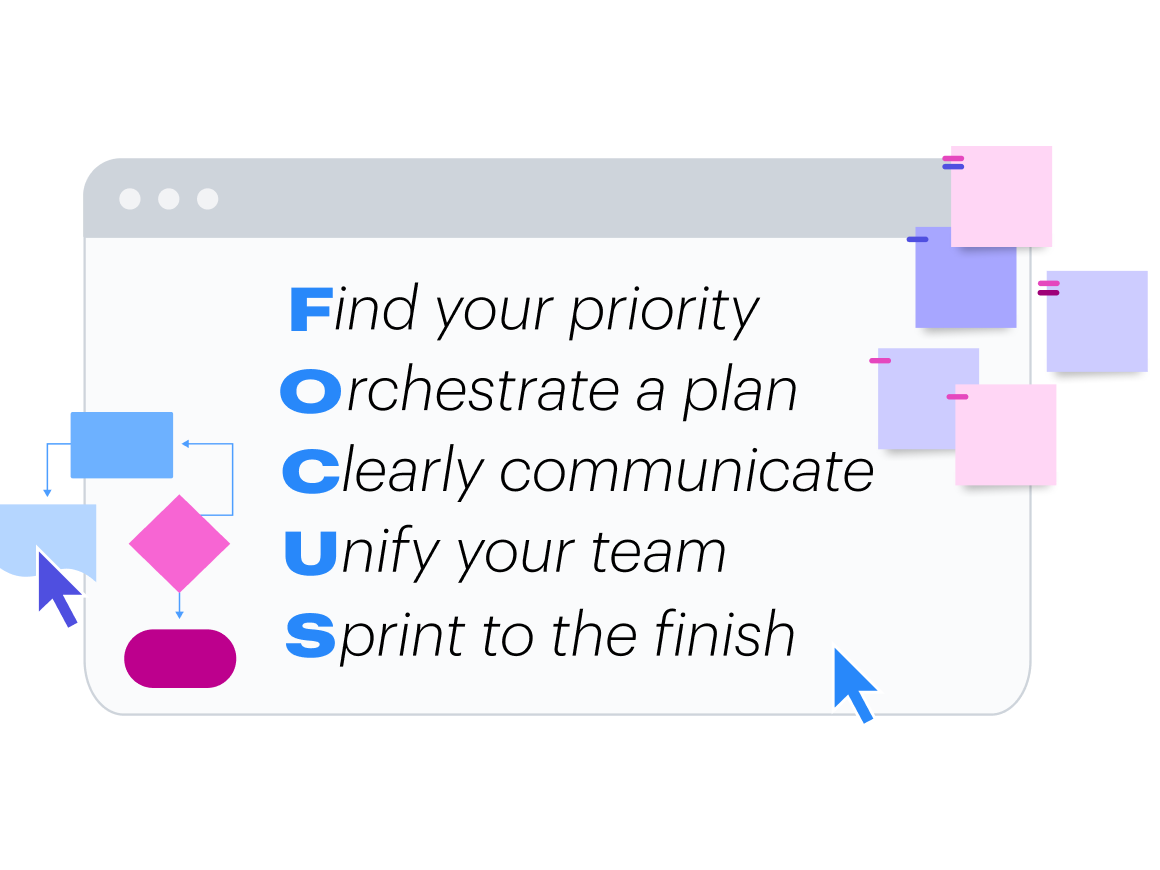
1. Find your priority
The first step is to identify your top priority. Effective prioritization here is less about what you decide to do, and more about what you decide not to do.
In our example of launching many new integrations in a short period of time, it was crucial to identify the trade-offs early on and make those decisions collaboratively so everyone was aligned from the beginning. In other words, we had to decide together what we were going to focus on and what we weren’t.
If you’re in a similar situation, here are a few templates you can use to find your priority:
- Priority matrix: A prioritization framework helps teams prioritize items based on their level of impact vs. required effort. So, whatever value you're providing is the impact, and whatever cost it takes to get there is the effort. We use this as a way to bucket different initiatives across the matrix and visualize the things we should be focusing on first.
Tasks that are highly impactful and inexpensive are high-priority to get across the finish line as quickly as possible. This template is a great way to pull the entire team together and make sure everyone is aligned and has a voice when it comes to setting the priority.
- Quantitative prioritization: If your prioritization matrix is too subjective (let’s say you have too many items clustered in the high-impact, low-cost field), you can use a quantitative prioritization chart to break them down even more. Here, you'll attach a quantitative value to each priority based on reach, impact, confidence, and ease. This is a simple but effective exercise for collaborating on priorities and organizing them in a systematic way.
- Buy a feature: The Buy a Feature exercise invites the team to think like an owner to identify the ROI of each potential feature. For instance, you can set a budget and say, “Hey team, you each get $500 to spend on a feature you think is the most impactful for us to build.” In the end, the goal is to arrive at two buckets of work: What should we do, and what should we not do?
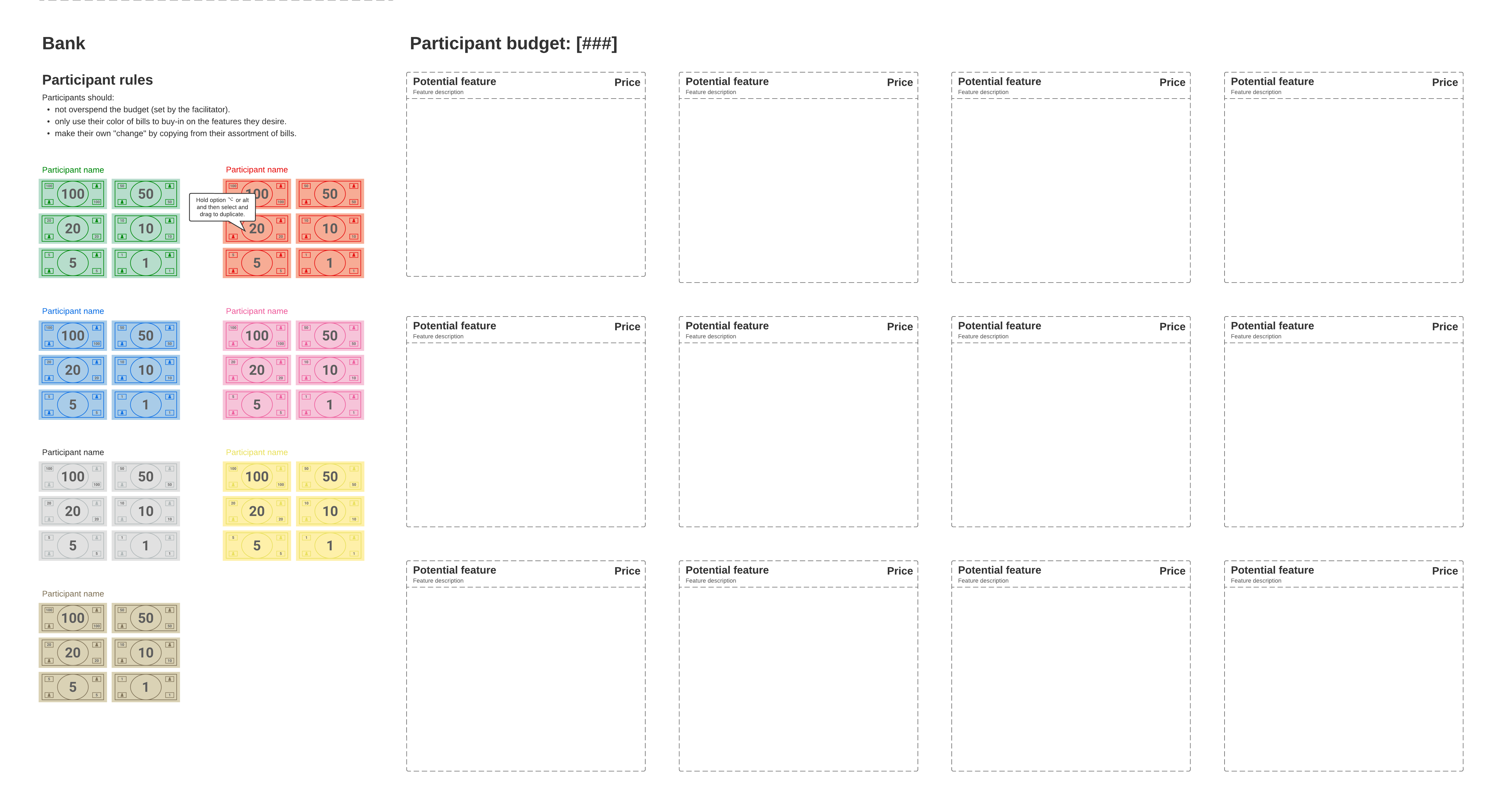
The key at this stage is focusing on why the work matters for your business. Don’t base your decisions on the resources available yet—that’s part of the planning phase.
2. Orchestrate a plan
Priorities don’t matter if you don’t have a plan to move them forward. Part of that process is understanding what resources you have and where and how to allocate them. Of course, people are our most valuable resources, so it’s essential to know who is available and what skills and experience they bring to the table.
From there, you can assemble your project team and begin organizing and assigning work to a timeline. Lucid’s org chart and timeline templates are great for this planning stage.
- Org chart: Import your employee data from an external source (such as Excel or Google Sheets) and visualize team structures at a glance. This makes it easy to see the makeup of each team, identify potential gaps, and move people around as needed to ensure teams are properly allocated.
- Timeline: With your teams mapped out, you can plot your project plans on a timeline. Lucid’s template makes it easy to create tasks and events, add assignees, and visualize the project plan from beginning to end.
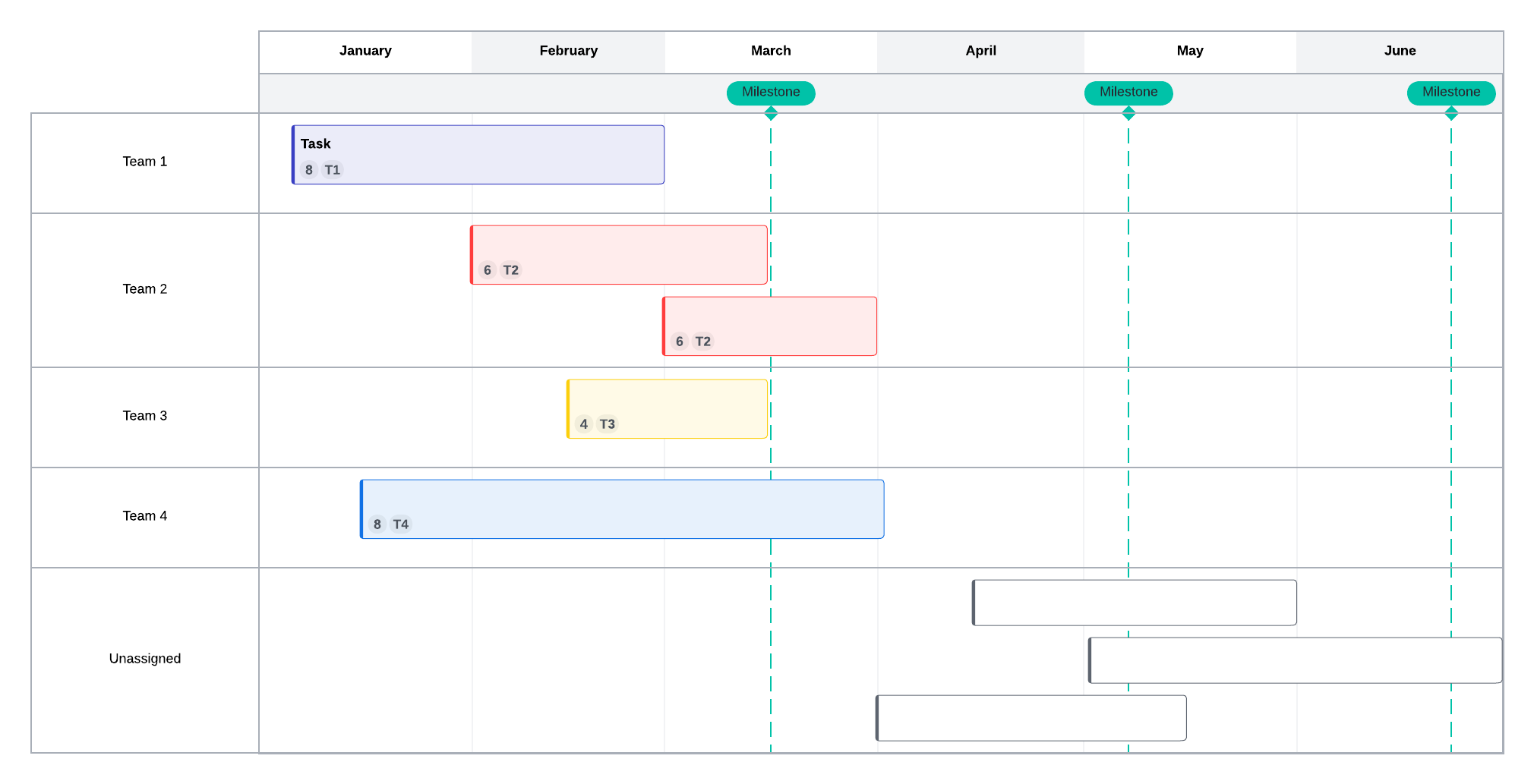
3. Clearly communicate
With a plan in place, it’s time to communicate with all key stakeholders and ensure everyone is aligned before moving forward. Be sure to communicate your priorities, the reasoning behind them, and the necessary trade-offs.
This is one of the most important steps when you're taking on a really big initiative and trying to get it across the finish line: You have to communicate what gets moved to the back burner, and why.
Lucid’s project dashboard template helped us do just that during our own integrations project. With 10 Scrum teams involved—plus product marketing, strategy, and business development teams—everyone had to be aligned on timelines and responsibilities.
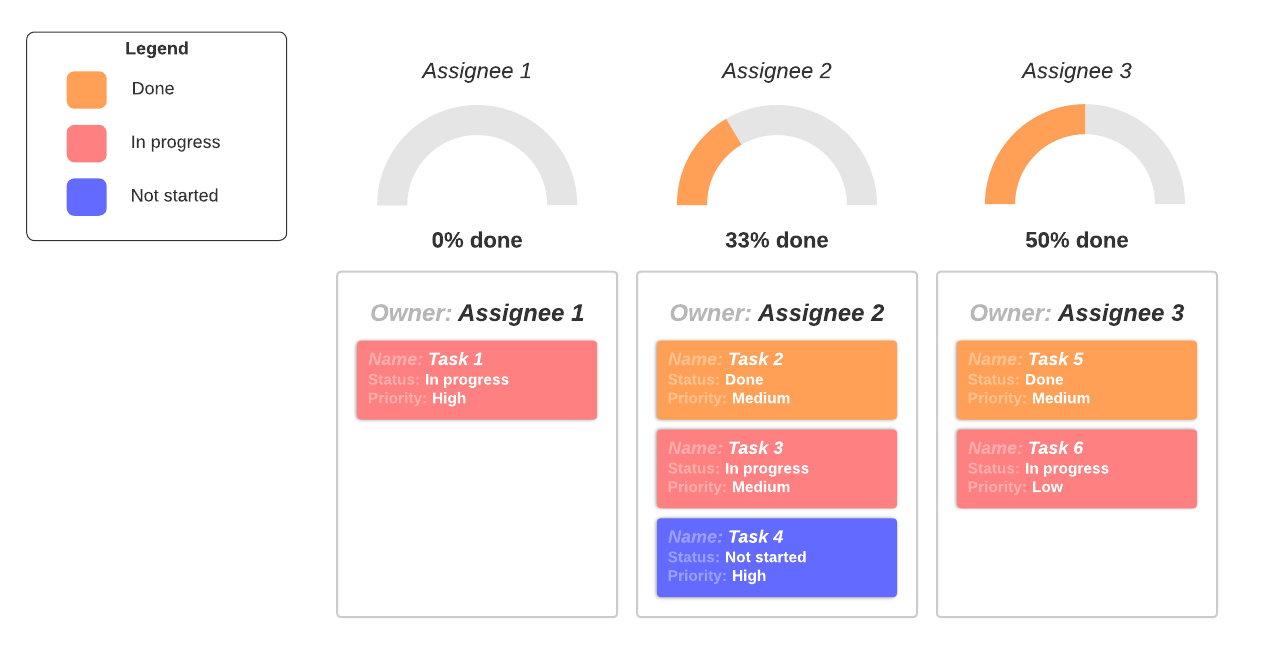
Lucid’s project dashboard puts all that information in one place for easy accessibility. For the integration project, the Lucid team used the project dashboard to clearly delineate:
- Who has ownership?
- Who's the point of contact here?
- What are the key milestones?
Within the integration project, not only did we have to manage the build on our end, but we also had to coordinate all the individual third-party approvals. There are so many things that had to line up in order to hit production milestones and go live on time, and we used a dashboard to surface all of that data and insights.
A project dashboard is also great for surfacing roadblocks. Teams can flag any issues or concerns that need to be resolved directly on the dashboard. This makes it easy for project managers to resolve issues quickly to ensure the project runs smoothly.
4. Unify your team
It’s no secret that the nature of work has changed since 2020. Gallup data published in 2025 shows that among U.S. workers with remote-capable jobs, 51% have hybrid arrangements, 28% are exclusively remote, and only 21% work on-site. So how can you get everyone unified in one place?
That’s one of the strengths of Lucid’s platform. Lucid enables streamlined communication, sharing, and collaboration in a virtual workplace for both synchronous and asynchronous work.
One of the best ways to get everyone on the same page is to use the war room (or team room) template. The war room template was designed with the idea to unify a team or organization’s knowledge base into one place.
For instance, Lucid’s team war room includes:
- The purpose statement
- The team roster so people can see who they’re working with and everyone’s roles
- The org chart embedded in the canvas
- The project calendar
Having all this in one place unifies otherwise siloed teams and information.
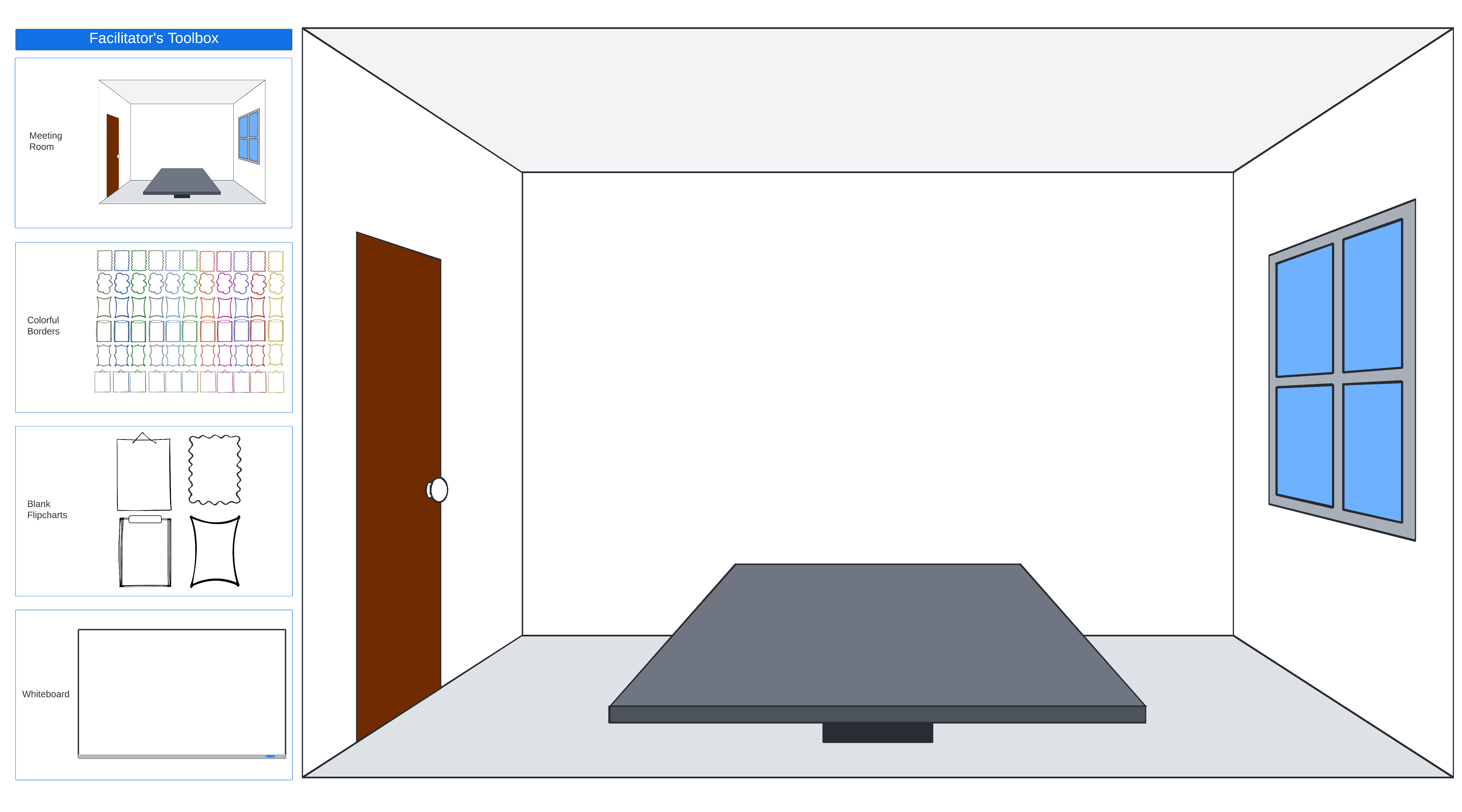
5. Sprint to the finish
With all those pieces in place, the final step is to get your priorities over the finish line as quickly as possible. Relying on the initial prioritization, planning, communication, and alignment stages sets the foundation for a focused sprint to the finish. Take advantage of Lucid’s collaboration resources and extensive template library to keep your team and other stakeholders on board.
Creating value with limited resources isn’t easy. But when you establish a culture of collaboration during market downturns, you'll set the foundation to be an innovative leader when times are good.
Update: Align product teams through airfocus
Since this article was published (and the related webinar was aired), Lucid announced our acquisition of airfocus, a simple yet powerful product management platform. By merging with Lucid, airfocus is helping even more product teams deliver value through:
- Seamless collaboration that enables cross-functional teams to gather input on an infinite Lucid canvas
- Smarter prioritization by moving from brainstorming in Lucid to structured prioritization in airfocus
- A visual source of truth achieved by centralizing roadmaps, user journeys, OKRs, and insights
"Joining forces with Lucid is a proud milestone,” said airfocus founder, Malte Scholz. “Together we’ll transform the way product teams collaborate, prioritize, and build the future." Learn more about how airfocus enables teams to implement the FOCUS framework.

Explore our innovation framework guide
Bring the power of visual collaboration to every part of your product development process. Get more than 30 templates you can use today.
Go to guideAbout Lucid
Lucid Software is the leader in visual collaboration and work acceleration, helping teams see and build the future by turning ideas into reality. Its products include the Lucid Visual Collaboration Suite (Lucidchart and Lucidspark) and airfocus. The Lucid Visual Collaboration Suite, combined with powerful accelerators for business agility, cloud, and process transformation, empowers organizations to streamline work, foster alignment, and drive business transformation at scale. airfocus, an AI-powered product management and roadmapping platform, extends these capabilities by helping teams prioritize work, define product strategy, and align execution with business goals. The most used work acceleration platform by the Fortune 500, Lucid's solutions are trusted by more than 100 million users across enterprises worldwide, including Google, GE, and NBC Universal. Lucid partners with leaders such as Google, Atlassian, and Microsoft, and has received numerous awards for its products, growth, and workplace culture.
